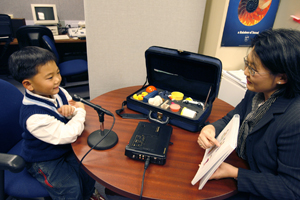Now You're Talking: Researcher Unravels How Children Learn to Speak

Lee is investigating how bilingual children who learn two languages simultaneously distinguish speech sounds.
Korean-English bilinguals are the seventh largest bilingual group in the U.S. and these languages have contrasting sound properties.
Sue Ann S. Lee, Ph.D., assistant professor in the Department of Speech-Language-Hearing Sciences, has received a grant from the National Institutes of Health (NIH) for her research titled, “Phonetic Category Formation in Korean-English Bilingual Children.”
Lee, a fluent Korean-English bilingual, is investigating how bilingual children who learn two languages simultaneously distinguish speech sounds appearing in both languages. In other words, she examines whether a 3-year-old Korean-English bilingual child can differentiate the English /p/ and the Korean /p/ when she or he produces ‘pie’ and ‘pal’ (foot in Korean).
These two /p/ sounds are produced differently by native speakers, but they sound similar to non-native listeners, Lee said. Some researchers suggest that bilingual children initially do not differentiate speech sounds in two languages while other group of researchers proposes that bilingual children differentiate detailed speech sounds at an early age.
Lee’s research provides important information to build theoretical framework for bilingual children’s speech acquisition. Her research will also provide important clinical and educational implications for bilingual children with speech sound disorders because the developmental speech patterns of normally developing children are commonly considered to be a diagnostic tool for speech disorders.
“If a bilingual child has a language or speech problem, it is likely that the child has problems in both languages,” Lee said. “In order to maximize treatment effectiveness, we have to treat both languages, not just the primary language. A common problem is that only a small number of bilingual children in the United States receive therapy in both languages.”
Lee said she would eventually like to determine whether the findings with Korean-English speaking children are similar in comparison to other bilingual children. In addition, Lee hopes her research will facilitate speech therapy for bilingual children at TTUHSC and across the nation.
Related
Beyond Aphasia: Understanding an Unknown Disorder
Your Kids' Speech: Summer Camp Focuses on Improving Communication Skills
Related Stories
Celebrating Veterans: TTUHSC’s General Martin Clay’s Legacy of Service and Leadership
From his initial enlistment in the Army National Guard 36 years ago to his leadership in military and civilian health care management roles, Major General Martin Clay’s career has been shaped by adaptability, mission focus and service to others.
Texas Tech University Health Sciences Center School of Nursing Named Best Accelerated Bachelor of Science in Nursing Program in Texas
The TTUHSC School of Nursing Accelerated Bachelor of Science in Nursing (BSN) program has been ranked the No. 1 accelerated nursing program in Texas by RegisteredNursing.org.
TTUHSC Names New Regional Dean for the School of Nursing
Louise Rice, DNP, RN, has been named regional dean of the TTUHSC School of Nursing on the Amarillo campus.
Recent Stories
TTUHSC Cancer Researcher Honored by National Academy of Inventors
C. Patrick Reynolds, M.D., Ph.D., director of the School of Medicine Pediatric Cancer Research Center at TTUHSC, has dedicated his life as a researcher to developing treatments for childhood cancers.
TTUHSC School of Nursing Celebrates 10 Years of the Veteran to BSN Program
The TTUHSC School of Nursing recognized the 10-year anniversary of the Veteran to Bachelor of Science in Nursing (VBSN) program during the fall 2025 commencement ceremonies held Dec. 13 in Lubbock, Texas.
TTUHSC Dean to be Inducted into the National Academies of Practice as Distinguished Fellow
Gerard E. Carrino, Ph.D., MPH, dean of the TTUHSC Julia Jones Matthews School of Population and Public Health, will be inducted into the National Academies of Practice (NAP) as a Distinguished Fellow of the Public Health Academy.
